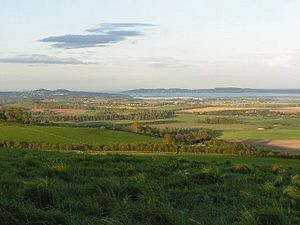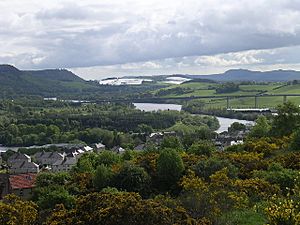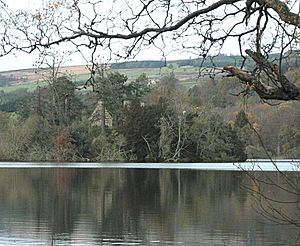Gowrie facts for kids

Gowrie (pronounced GOV-uh-ree) is a historic region in central Scotland. It was one of the original areas that made up the Kingdom of Alba, which was an early name for Scotland. Gowrie covered the eastern part of what is now Perthshire. It was located just east of another region called Atholl.
The main town in Gowrie is the city of Perth. Today, when people talk about Gowrie, they often mean the Carse of Gowrie. This is a flat, fertile area south of the Sidlaw Hills, stretching from Perth eastwards to Dundee.
Exploring Gowrie's Landscape
Gowrie is famous for having some of the best farmland in all of Scotland. This rich land was a big reason why the area was so important throughout Scottish history. The southern part of the region, the Carse of Gowrie, has even been called the "Garden of Scotland" because of its fertile soil.
Many towns and interesting places are found in Gowrie. For example, Coupar Angus is a town that sits right on the border between Gowrie and another region called Angus. Blairgowrie, whose name means "Plain of Gowrie," was called "Blair in Gowrie" long ago to tell it apart from other places named Blair.
Here are some of the towns and places you can find in Gowrie:
- Alyth
- Blairgowrie
- Cargill
- Clunie
- Coupar Angus
- Errol
- Forteviot
- Inchture
- Kinfauns
- Longforgan
- Perth
- Scone
The exact borders of Gowrie might have changed a bit over time due to different political situations.
Gowrie's Royal Past

Gowrie was a very important place in early Scottish history. The Scottish kings were crowned at Scone, which is located in Gowrie. This region, with places like Scone and Forteviot, was clearly a central part of the early Kingdom of Scotland.
In the 1100s, the king owned several important estates in Gowrie. These included Scone, Strathardle, Longforgan, and Coupar. The king also held the rest of the region as its mormaer, which was a title similar to an earl or a powerful regional ruler.
Around the 1100s, a new town called a burgh was started in Gowrie at Perth. A sheriff (a royal official who enforced laws) was also appointed for Gowrie, sometimes called the "Sheriff of Gowrie" or "Sheriff of Scone." Perth and Scone were very close, so their sheriffs might have been the same person or became the same over time.
Gowrie also had special law experts called judices or "Brehons" from the 1100s to the 1300s. These people were like legal advisors for the region. They knew the local laws and customs, helping to keep order. It's likely that every region in Scotland had similar law experts.
Most of the churches in Gowrie were overseen by the Bishop of St Andrews. There was a Dean of Gowrie who worked under this bishop. A few churches were also under the control of the bishops of Dunblane and Dunkeld.
The Earls of Gowrie
The title of Earl of Gowrie was created in 1581 for William Ruthven. Later, in 1600, the earldom was taken away from his son, John Ruthven, 3rd Earl of Gowrie, because of a famous event known as the Gowrie Conspiracy. The title of Earl of Gowrie was brought back much later, in 1945, for a descendant of the second Earl.
In the mid-1800s, local government in Scotland changed. The old regions like Gowrie were replaced by new areas called Counties or shires. These new counties were based on the areas managed by sheriffs. Because of these changes, Gowrie became part of the new Perthshire.



